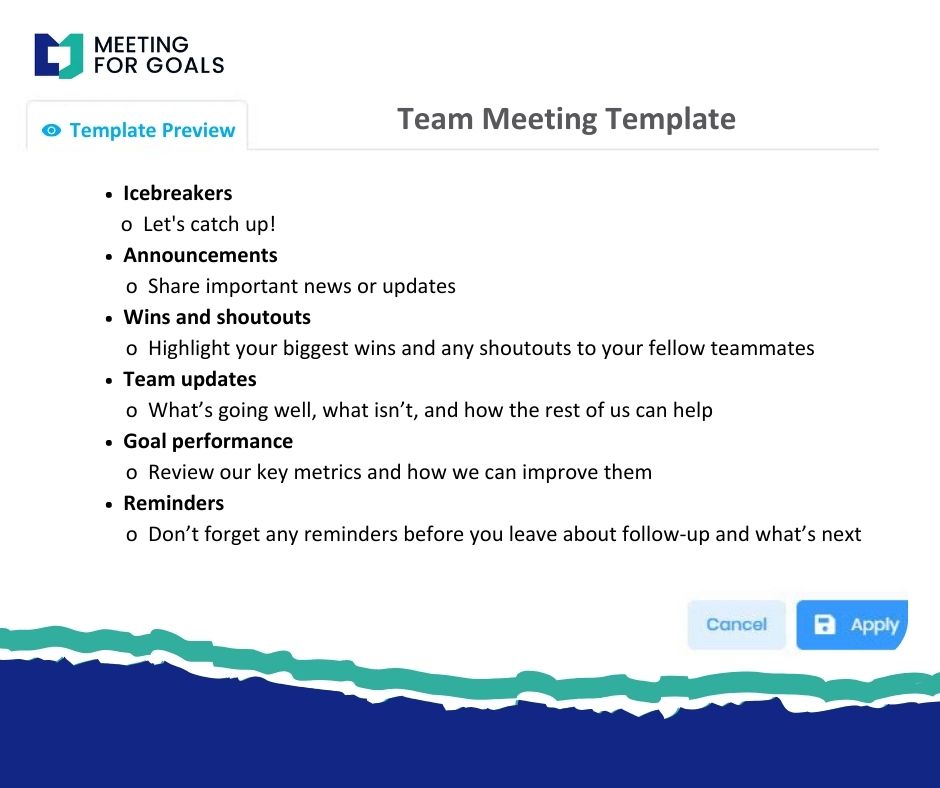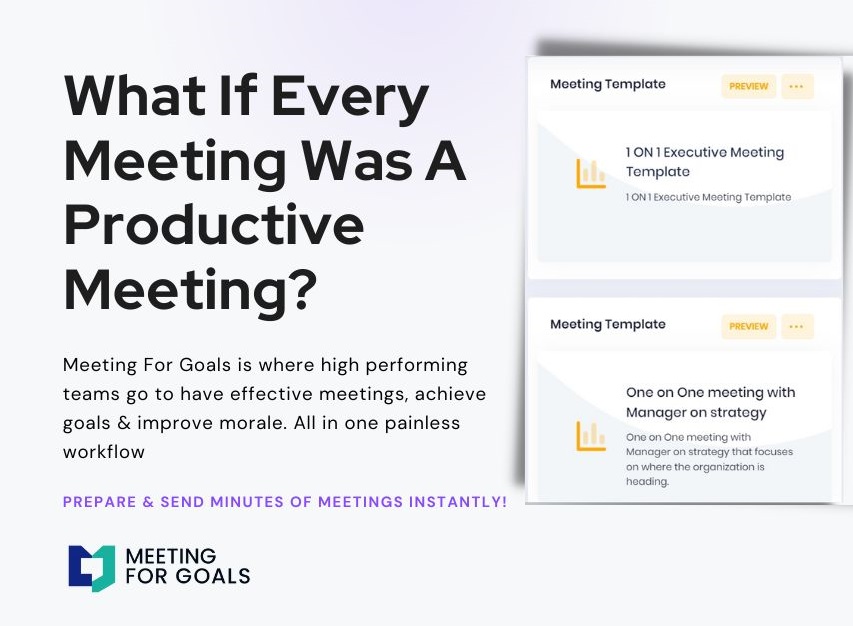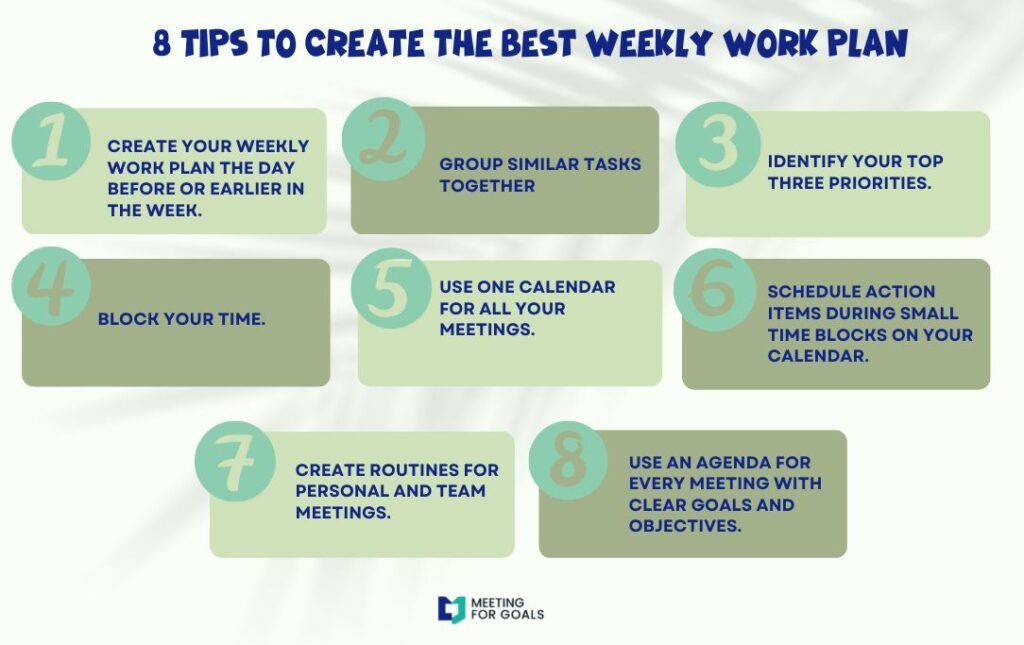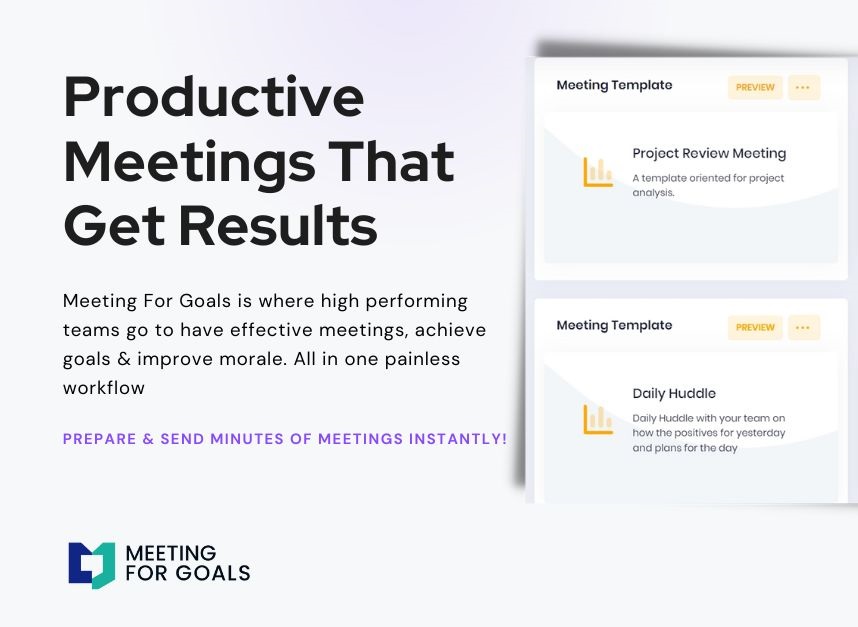One-on-One Meeting with Manager: A Guide to Questions and Answers
In today’s fast-moving business world, one-on-one meetings are more than just quick check-ins—they’re powerful tools for team alignment, employee development, and performance improvement. For growing companies with 40 to 70 employees, especially those led by Directors, VPs, and C-suite leaders, these meetings can be the difference between thriving and falling behind.
This guide breaks down how to get the most out of your one-on-one meetings—whether you’re a manager or a team member. You’ll learn how to prepare, what questions to ask, how to respond thoughtfully, and how to use Meeting For Goals to make every meeting more focused and productive.
👉 Ready to level up your meetings? Sign up now at https://app.meetingforgoals.com/TenantRegistration/Register
I. Introduction
One-on-one meetings are the heartbeat of strong leadership and team connection. Especially in mid-sized companies, these meetings bridge the gap between big-picture goals and daily execution.
They’re not just about status updates. They’re a chance to:
- Align on priorities
- Give and receive feedback
- Support career growth
For executives and managers, these meetings offer insights into team morale, performance challenges, and innovation opportunities.
But great meetings don’t happen by chance. They require structure, preparation, and the right tools. That’s where Meeting For Goals comes in. Our meeting management software helps teams stay aligned, track progress, and have more meaningful conversations.
This article will walk you through how to prepare for your one-on-one meetings, ask impactful questions, respond with clarity, and use Meeting For Goals to turn every meeting into a growth opportunity.
2 Minute Video
Watch a 2 minute demo of our meeting management software in action
II. Preparing for the One-on-One Meeting
Preparation is key. Without it, meetings can feel aimless and unproductive. With it, you can turn a 30-minute chat into a strategic conversation.
A. Why Both Managers and Employees Should Prepare
Managers should come prepared with updates on team projects, performance insights, and feedback. Employees should think about recent wins, current challenges, and future goals.
When both parties prepare, the meeting becomes proactive—not just reactive. You’re not just talking about what happened, but planning what’s next.
B. Setting Clear Objectives
1. Identify Key Topics
Before the meeting, jot down what you want to cover. This could be:
- Project updates
- Roadblocks
- Feedback
- Career development
Prioritize the most important topics so nothing critical gets missed.
2. Revisit Goals
One-on-ones are a great time to check in on personal and professional goals. Employees should reflect on progress and identify areas where they need support. Managers can help tie individual goals to team or company objectives.
C. How Meeting For Goals Helps with Preparation
Meeting For Goals makes it easy to get ready. You can:
- Set shared agendas
- Review past notes
- Link talking points to company goals
All in one place. This saves time and keeps meetings focused.
Plus, you can use our free meeting templates to jumpstart your agenda planning: https://meetingforgoals.com/meeting_templates
Adding an Agenda
How to add an agenda instantly on Meeting For Goals
III. Key Questions to Ask Your Manager
Asking good questions shows initiative and helps you grow. It also builds a stronger relationship with your manager.
A. Questions About Performance and Feedback
1. “Can you give me feedback on my recent work?”
This shows you’re open to learning and care about doing your best.
2. “What could I be doing better?”
Asking this helps you identify blind spots and shows a commitment to improvement.
B. Questions About Career Development
1. “What growth opportunities do you see for me?”
This opens the door to career conversations and helps your manager think about your future.
2. “Would you consider mentoring me or recommending someone who could?”
Mentorship can be a game-changer. Asking for it shows ambition and humility.
C. Questions About Team Dynamics
1. “How do my contributions support the team’s goals?”
This helps you understand your impact and stay aligned with team priorities.
2. “Is there anything I can do to better support the team?”
This shows you care about collaboration and team success.
With Meeting For Goals, you can keep track of these questions and answers over time. This makes it easy to follow up and show progress.
IV. Crafting Suitable Responses to Manager Questions
Great one-on-ones aren’t just about asking questions—they’re also about giving thoughtful answers.
A. Common Questions Managers Might Ask
1. “What challenges are you facing?”
Be honest. Share what’s tough, but also talk about how you’re working through it.
2. “Where do you see yourself in the next year or two?”
This helps your manager understand your goals and how to support your growth.
B. How to Respond with Accountability
1. Highlight Wins and Challenges
Use examples and data when possible. Talk about what went well and what you learned from any difficulties.
2. Focus on Solutions
If you’re struggling in an area, talk about what you’re doing to improve. This shows initiative and resilience.
C. Using Meeting For Goals to Prepare
With Meeting For Goals, you can track your:
- Achievements
- Challenges
- Action items from previous meetings
This makes it easier to prepare thoughtful responses and demonstrate progress.
When your manager asks, “How’s it going?” you’ll have clear answers backed by data.
V. Effective Communication During the Meeting
How you communicate can be just as important as what you say. Good communication builds trust and keeps the conversation productive.
A. Keep It a Two-Way Conversation
1. Practice Active Listening
Make eye contact, take notes, and don’t interrupt. Show you’re engaged by summarizing what your manager says and asking follow-up questions.
2. Invite Honest Feedback
Let your manager know you’re open to feedback—even the tough stuff. This creates a safe space for real conversations.
B. Keep It Respectful and Constructive
- Use “I” statements to express your thoughts without blame.
- Stay calm and focused, even when discussing challenges.
- Look for solutions, not just problems.
C. Document Insights with Meeting For Goals
Meeting For Goals lets you capture:
- Key takeaways
- Action items
- Feedback
All in one place. This helps avoid misunderstandings and ensures everyone’s on the same page.
You can also revisit past meetings to track progress and follow through on commitments.
Want to make your next one-on-one more impactful? Explore our meeting templates here: https://meetingforgoals.com/meeting_templates
VI. Going Beyond the Basics: Advanced Tips for High-Impact One-on-Ones
A. Schedule Regularly, Not Randomly
Consistency builds trust. Whether it’s weekly, biweekly, or monthly, keep a regular cadence. This shows that the meeting—and the relationship—matters.
B. Use the Meeting to Drive Strategy
One-on-ones aren’t just for operational updates. Use them to connect the dots between day-to-day work and long-term goals. Discuss how individual performance supports company strategy.
C. Bring Data to the Table
Use metrics to support your points. Whether it’s:
- Project timelines
- KPIs
- Customer feedback
Data adds credibility to your updates and helps drive decisions.
D. End with Action Items
Always wrap up with clear next steps. Who’s doing what by when? Use Meeting For Goals to assign action items and set deadlines so nothing falls through the cracks.
E. Explore Other Resources
Want to dive deeper into effective one-on-one meetings? Check out this helpful guide from Harvard Business Review on how to make one-on-ones more productive: https://hbr.org/2016/08/what-to-do-if-your-boss-doesnt-give-you-feedback
You can also explore Atlassian’s team playbook for running effective meetings: https://www.atlassian.com/team-playbook/plays/1-1-meeting
These resources, combined with Meeting For Goals, can help you elevate your meeting game.
VII. Conclusion
One-on-one meetings aren’t just a checkbox—they’re a chance to connect, align, and grow. With the right preparation, questions, responses, and tools, these meetings can become a powerful driver of performance and engagement.
For companies with 40 to 70 employees, especially those led by senior leaders, optimizing one-on-ones is essential. That’s where Meeting For Goals shines. Our platform helps you:
- Prepare smarter
- Communicate better
- Track progress
- Align with goals
Whether you’re a manager looking to inspire your team or an employee ready to grow your career, Meeting For Goals gives you the tools to make every meeting count.
👉 Ready to transform your one-on-ones? Sign up today at https://app.meetingforgoals.com/TenantRegistration/Register
👉 Explore our free meeting templates at https://meetingforgoals.com/meeting_templates
👉 Learn more at https://meetingforgoals.com
Let’s turn meetings into momentum—one conversation at a time.
Word Count: ~2,100+ words
SEO Keywords: one-on-one meeting with manager questions and answers, effective one-on-one meetings, meeting management software, team productivity, employee development, performance feedback, Meeting For Goals, manager-employee meeting tips, leadership communication, career growth discussions
Meta Description: Discover how to make the most of your one-on-one meetings with your manager. Learn the best questions to ask, how to respond effectively, and how Meeting For Goals can help you align, grow, and save time.




